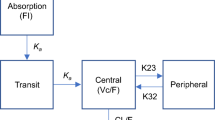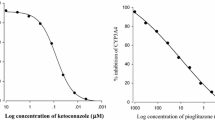Abstract
Purpose. The effect of hyperlipidemia on nifedipine pharmacokinetics was studied. The mechanisms by which hyperlipidemia affects pharmacokinetics of drugs are mainly undetermined. Hyperlipidemia may decrease the fraction of unbound drug in plasma and/or decrease intrinsic ability of the cytochrome P-450 systems due to excess membrane cholesterol. Hyperlipidemia is a primary risk factor for coronary artery disease leading to hypertension and ischemic heart disease, for which nifedipine, a calcium channel blocker, is used.
Methods. Poloxamer 407 (P407)-induced hyperlipidemic rat model was used to study the effects of hyperlipidemia on the pharmacokinetics of nifedipine (6 mg kg−1 given iv, ip and po). Total plasma cholesterol levels increased from 0.82−2.02 to 5.27−11.05 mmol L−1 48 h post P407 administration (Ig kg−1, ip). Protein binding studies were conducted by an ultrafiltration method.
Results. Hyperlipidemia significantly decreased CLTB by 38% and CLTB/F by 45 and 42% following po and ip doses, respectively, thereby increasing AUC0−∞, Cmax and half-life. Absolute bioavailability and Vdss remained unchanged. AUC0−∞ was affected to the same extent in each route of administration, therefore, the effect was mainly systemic rather than presystemic. Hyperlipidemia significantly lowered the fraction unbound in plasma by approximately 31%.
Conclusions. The altered pharmacokinetics of nifedipine by P407-induced HYPERLIPIDEMIA may be, at least in part, due to the decrease in fraction unbound in plasma. A decrease in intrinsic clearance, however, cannot be ruled out.
Similar content being viewed by others
REFERENCES
R. Talbert. Hyperlipidemia. DePiro Textbook of Therapeutics, Appleton and Lange, Connecticut, 1997, pp. 357–386.
T. C. Kwong, J. D. Sparks, and C. E. Sparks. Lipoprotein and protein binding of the calcium channel blocker diltiazem. Proc. Soc. Exp. Biol. Med. 178:313–316 (1985).
A. T. Remaley, U. K. Schumacher, H. R. Amouzadeh, B. Brewer, and J. M. Hoeg. Identification of novel differentially expressed hepatic genes in cholesterol-fed rabbits by a non-targeted gene approach. J. Lip. Res. 36:308–314 (1995).
H. Rosenkranz, K. Schlossmann, and W. Scholtan. [The binding of 4-(2′-nitrophenyl)-2,6-dimethyl-1,4-dihydropyridine-3,5-dicarboxylic acid dimethyl ester (nifedipine) as well as other coronary active substances to serum albumins]. Arzneimittelforschung 24:455–466 (1974).
T. P. Johnston and W. K. Palmer. Mechanism of poloxamer 407-induced hypertriglyceridemia in the rat. Biochem. Pharmacol. 46:1037–1042 (1993).
J. S. Grundy, R. Kherani, and R. T. Foster. Sensitive high-performance liquid chromatographic assay for nifedipine in human plasma utilizing ultraviolet detection. J. Chromatogr. B Biomed. Appl. 654:146–151 (1994).
J. S. Grundy, L. A. Eliot, and R. T. Foster. Extrahepatic first-pass metabolism of nifedipine in the rat. Biopharm. Drug Dispos. 18:509–522 (1997).
T. S. Foster, S. R. Hamann, V. R. Richards, P. J. Bryant, D. A. Graves, and R. G. McAllister. Nifedipine kinetics and bioavailability after single intravenous and oral doses in normal subjects. J. Clin. Pharmacol. 23:161–170 (1983).
R. Poledne. Cholesterol metabolism in prague hereditary hypercholesterolemic rat. In M. J. Halpern (ed.), Lipid metabolism and its pathology. Proceedings of the IVth international colloquium on lipid metabolism and its pathology, Excerpta medica, Amsterdam, 1986, pp. 185–189.
D. Luke. Immunosuppressive effect of cyclosporine in the hyperlipidemic rat model. Biopharm. Drug Dispos. 13:635–645 (1992).
J. Nemunaitis, H. J. Deeg, and G. C. Yee. High cyclosporin levels after bone marrow transplantation associated with hypertriglyceridemia. Lancet 27:744–745 (1986).
A Lindholm and S. Henricsson. Intra-and interindividual variability in the free fraction of cyclosporine in plasma in recipients of renal transplants. Ther. Drug Monit. 11:623–630 (1989).
S. Bower. Plasma protein binding of fentanyl: the effect of hyperlipoproteinaemia and chronic renal failure. J. Pharm. Pharmacol. 102–106 (1982).
A. Danon and Z. Chen. Binding of imipramine to plasma proteins: Effect of hyperlipoproteinemia. Clin. Pharm. Ther. 25:316–321 (1998).
J. Oravcova, D. Sojkova, N. Fetkovska, and T. Trnovec. Factors influencing isradipine and amlodipine binding to human plasma lipoproteins. Blood Press. 1:61–64 (1994).
Author information
Authors and Affiliations
Corresponding author
Rights and permissions
About this article
Cite this article
Eliot, L.A., Foster, R.T. & Jamali, F. Effects of Hyperlipidemia on the Pharmacokinetics of Nifedipine in the Rat. Pharm Res 16, 309–313 (1999). https://doi.org/10.1023/A:1018896912889
Issue Date:
DOI: https://doi.org/10.1023/A:1018896912889




